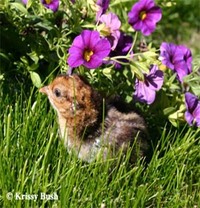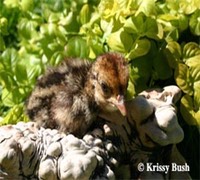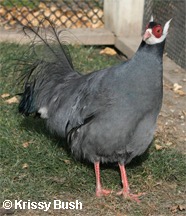Scientific Information
Class: Aves
Order: Galliformes
Family: Phasianidae
Subfamily: Phasianinae
Genus: Crossoptilon
Species: Crossoptilon auritum
Species English name: Blue Eared Pheasant
CITES Status: not endangered
Distribution: Himalayas - Northern China
(from A Monograph of Pheasants Volumes I & II, William Beebe)
Description
• Male and female are very similar in appearance. Black crown, bright red wattles, reddish legs, & white ear tufts that continue under the chin. Blue-grey neck, and wings. Wings have a brownish hue at the tips of the feathers. Some of the tail is the same colour as the body while other feathers are white with dark ends.. Males are usually larger than females and males possess large round spurs while the females have small oval spurs.
• Extremely hardy birds. They love snow and inclement weather.
Diet
• We feed our breeders and young adults 16% layer pellets, our tiny chicks 25% Turkey Starter crumble, and our growing chicks 20% crumble.
• Blue Eared love treats of any kind. They get a handful of mixed grains every second day except during breeding season. They also get fresh greens (lettuce, chickweed, dandelions, grass) and fruits & vegetables (tomato, grapes, berries, etc.) when available.
Breeding
• Done in pairs. Eared are very monogamous birds and become very attached to their mate. Trios are not recommended because the dominant female will usually try to kill the less dominant female.
• Blue Eared are first year birds meaning that the female will lay eggs in her first year. Males are fertile in their first year.
• They start laying eggs approximately the 3rd week of April and will lay every second day until they lay up to 20 eggs.
• They lay very large round greyish or greyish-brown eggs.
Incubation
• Eggs are collected twice a day and marked with the date and breeding pen number and set daily.
• Eggs are set in an automatic turning Lyons Roll-X (RX2) with grid 89
• Temperature 99.8°F, humididty-wet bulb 82 with humidity adjusted periodically depending on development of the air space shown by candling
• On the final day of incubation, each egg is placed in its own oval wire mesh hatching basket (6" x 3" x 3") and set in the Sportsman Ratite hatcher.
• Incubation for Blue Eared is 26 days.
• After the chick hatches, it stays in the hatcher for a minimum of 8 hours.
Chicks
• When the chicks come out of the incubator they are lively and rambunctious. They are very large and leggy compared to most of the other kinds of pheasant chicks. They are a tawny brown colour with a whitish-cream chest and belly and a golden brown face and head. A distinctive feature of these chicks is that they always look like they are smiling.
• They start out in our round 18" brooder pen with a mixed assortment of chicks. After a few days they are separated into an all Eared 2' x 4' baby pen for about a week. They are then transferred to an all Eared 2' x 6' pen for the next 7-9 weeks. During this time, they are separated into separate Brown and Blue Eared pens to minimize fighting once we have enough chicks of both varieties. All of these brooding pens have wire bottoms with a heat lamp at one end and feed & water at the other end. The heat lamp is attached to a dimmer switch so we can turn down the amount of heat as the chicks get older until it is turned off completely.
• After they are off of the heat for a few weeks, they are moved outside to the pheasant house (has outside grassy pens and a heated inside house part where they are blocked in for the night). After they are toughened up, they are moved to an outside chick pen.
• Blue Eared chicks have a tendency to be violent and will kill other chicks when over crowded. We de-beak our Eared chicks very frequently to minimize problems. You should not mix chicks of different of ages and sexes.
Pens
• 25' long x 10' wide x 6' high with a 4' x 4' x 4' house in the middle.
• Pens are covered with 2" diamond top-rite.
• Pens contain grass, but since Blue Eared are rooters, they need to move to another pen every 1-3 years to let the grass come back.
• See Scintillating Copper Article for predator proofing set-up
Behavior
• They are very easy to tame down and are incredibly friendly and curious birds. Most will tame down enough to eat out of your hand or follow you around. Some learn how to do tricks and chicks are quite eager to sit on your hand or shoulder.
• The males can become aggressive enough to attack humans during breeding season. Some males will continue to attack humans year-round.
• They are very calm and non-flighty birds that love to show off when any one is watching.
• Males will often turn to one side and lower one wing to assert their dominance. Females will crouch down and make purring like noises during breeding season.
• Eared love to dust and sun themselves. They also love to play in the mud and will tip waterers to make mud.
Article By Krissy & Donna Bush
Pheasant Ridge


